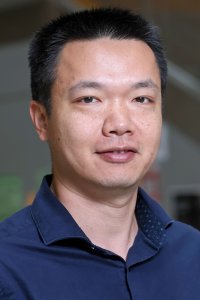Insights Into Evolution
Ohio Wesleyan Professor Contributes to New Research Published in Nature Physics Journal

DELAWARE, Ohio – Ohio Wesleyan University's Hanliang "Han" Guo, Ph.D., is the co-author of newly published research that "potentially provides fundamental insights of early evolution of multicellular organization."
The research, "Cooperative hydrodynamics accompany multicellular-like colonial organization in the unicellular ciliate Stentor," appears in the latest edition of the peer-reviewed scientific journal, Nature Physics.
Guo, an assistant professor of Mathematics and Computer Science, said the collaborative research explores the evolution of early single-celled organisms into more complex multicellular ones, a phenomenon that he describes as "perhaps one of the most interesting questions in life."
"While many single-celled organisms exhibit both solitary and colonial existence, the organizing principles governing the transition and the benefits endowed are less clear," said Guo, who joined the Ohio Wesleyan faculty in 2022. "The study of the transition has traditionally focused on species that form a colony with physical linkages between colony members. … However, if we go a step backward, the majority of known colony-forming protists (single-cell organisms) form colonies without observable linkages, and the colony formation is ephemeral (short-lived).
"In this work," he explains, "we focus on one such species, Stentor coeruleus, and demonstrate the benefit of a dynamic-colony formation from a hydrodynamics point of view." (Hydrodynamics explores the motion of fluids and the forces affecting solid bodies immersed in them.)
Stentors are large single-celled pond organisms with a distinct trumpet shape. The researchers chose to work with them, Guo said, because they repeatedly switch between swimming and sessile (non-moving) modes.
"When in sessile mode," Guo said, "Stentors usually form a flower-like colony where individuals constantly sway their heads. When in swimming mode, the Stentors move solitarily. Our collaborators found that, through experiments, Stentor pairs generate stronger feeding currents compared to solitary Stentors. The question is, however, why would Stentors go back to isolated swimming mode if working collectively is so advantageous? The group hypothesized that it is because the benefit for individual Stentor is not uniform: weaker Stentor takes advantage of stronger ones when in close proximity."
To test their hypothesis, Guo said, "We placed Stentor pairs under the microscope and measured the feeding currents generated by the ciliary beatings on the 'mouth' of the Stentors. Additionally, we proposed a minimalistic mathematical model that can faithfully capture the salient ingredients of the experiments, including the strength and spatial configuration of Stentors, while overcoming experimental limitations such as boundary effects imposed by the coverslips."
Guo, primarily responsible for the mathematical modeling component of the research, said the model supported the group's experimental observation, which essentially shows that weaker Stentors gain more from partnering than stronger Stentors" and that "individuals in a dynamic colony have stronger feeding flows on average – providing an explanation of the constant head-swaying observed in experiments."
What does this mean in terms of the evolution of single-celled organisms?
"Our work only focuses on a small, yet important, part that could affect early evolution, namely the hydrodynamic benefit on nutrient uptake," Guo said. "Other benefits of multicellularity such as better defense mechanisms against predators and better division of labor are not considered in this work. Obviously, the study of early evolution has been an exciting topic for many scientists for many decades – we just move a small step at a time."
Guo began work on the project in 2018 at the request of a group of biologists from the Marine Biological Laboratory at Woods Hole, Massachusetts. The research is ongoing, and in 2024, Guo earned a three-year AMS-Simons Foundation Research Enhancement Grant for Primarily Undergraduate Institution Faculty to support it. The $9,000 grant will enable Guo to hire a current Ohio Wesleyan student to work as his research assistant during each of the next three academic years.
Additional authors of the new Nature Physics article and their academic affiliations are Shashank Shekhar of Emory University in Atlanta, Georgia; Sean P. Colin of Roger Williams University in Bristol, Rhode Island; Wallace Marshall of the University of California San Francisco; Eva Kanso of the University of Southern California in Los Angeles; and John H. Costello of Providence College in Providence, Rhode Island. Learn more about their work at www.nature.com/articles/s41567-025-02787-y.
Learn more about Ohio Wesleyan's Guo and the OWU Department of Mathematics and Computer Science at owu.edu/math.
Founded in 1842, Ohio Wesleyan University is one of the nation's premier liberal arts universities. Located in Delaware, Ohio, the private university offers more than 70 undergraduate majors and competes in 24 NCAA Division III varsity sports. Through its signature experience, the OWU Connection, Ohio Wesleyan teaches students to understand issues from multiple academic perspectives, volunteer in service to others, build a diverse and global perspective, and translate classroom knowledge into real-world experience through internships, research, and other hands-on learning. Ohio Wesleyan is featured in the book "Colleges That Change Lives" and included on the U.S. News & World Report and Princeton Review "Best Colleges" lists. Connect with OWU expert interview sources at owu.edu/experts or learn more at owu.edu.
